In clinical practice a dentist often encounters patients with different pathologies of the chewing- vocal apparatus, which are manifested by reduced height of gnathic part of the face as one of characteristic features of impairment. Quite a number among these are patients with increased dental abrasion: from 11.8 % to 42.6 % of cases [3, 4, 8, 12, 17, 18].
The cases of increased abrasion of teeth are likely to be caused by various reasons: morphological inferiority of hard tissues of teeth, overloading of teeth, chemical exposure, occupational hazards, functional status of the masticatory muscles and temporomandibular joints (TMJ) and others [2, 3, 4, 5, 8, 9, 10, 11, 15].
In the practice of prosthetic dentistry temporomandibular joint is of great importance. It is known that any dental intervention in the maxillofacial region affects the TMJ to a less or greater extent [2, 4, 12, 13, 14, 16].
Most researchers recognize the relationship between the structure of the TMJ and type of occlusion [1, 4, 5, 8, 14].
Currently existing classification of increased abrasion do not meet the systematization of the clinical manifestations of this disease [3, 5, 10, 11, 12, 15]. If the horizontal form of abrasion is clinically determined reliably, vertical and mixed as well as all other forms distinguish from each other only conditionally. Therefore, we singed out alongside the horizontal form vertical and vertically distal-mesial ones, depending on the type of bite and position of elements of the temporomandibular joints. Gnathic part of the person’face is a variable structure of the craniofacial complex. The most susceptible to change are vertical parameters, which is associated with anatomical-physiological characteristics of growth and development of the head (the change of teeth, anomaly of occlusion, loss of teeth, increased dental abrasion, etc.). Increase in the height of gnathic part of the person’s face can lead to a change in the tone of masticatory muscles and cause dysfunction of temporomandibular joints [4, 5, 8, 10, 14, 16].
The purpose of the work
To study the efficacy of treatment prediction of patients with vertically-distal form of increased abrasion of teeth according to the position of the elements of the temporomandibular joints with the use of computer programmes and on the basis of their findings – assessing the quality of dental prosthetics.
Materials and methods of research
We examined 61 patients (31 women and 30 men) with a vertically distal form of increased abrasion of teeth, 28 of them (17 men and 11 women) with compensated and 33 (14 women and 19 men) with decompensated form. Decompensated vertically- distal form of PSZ is characterized by the reduction of gnathic part of the face, while in case of compensated form reduced gnathic part of the face was not observed (or only mild reduction) due to vacant (false, substitution, reversible) hypertrophy of bone tissue of alveolar ridges of the upper and lower jaws. All patients noted various defects of dentition, but less than 6 teeth antagonists were not observed.
The distribution of patients with PSZ by age and sex are presented in table 1.
Table 1
|
Age |
31–40 |
41–50 |
51–60 |
61 and older |
|
Women |
7 |
8 |
13 |
3 |
|
Men |
8 |
9 |
12 |
1 |
|
Total |
15 |
17 |
25 |
4 |
Roentgenologic teleroentgenogram analysis was performed by means of a computer program [19], which allows to identify anthropometric points, to build a cephalometric plane to roentgenogrammetry and formulate the preliminary diagnosis. In the study we used one angular dimension (angle n – ss – spm) and six linear (sna' – Kme'; sn'- Kme'; gox; goy; cox ; coy) (Fig. 1).
We proposed a method for studying tomograms of temporomandibular joints on the bases of the issues including the measurement of the sagittal size of the glenoid fossa of the line drawn from the lower edge of the articular tubercle to the lower edge of the external auditory canal, measuring the width of the lower jaw head, the angle of inclination of the slope of the articular tubercle, the dimension of the joint space in front, upper front, upper rear and rear parts due to the depth of the temporomandibular fossa and the configuration of the lower jaw head (Fig. 2).
The proposed calculation formula:
Δh = K x [(DR1 + DR2 + DR3 + DR4 + + DL1 + DL2 + DL3 + DL4):8 – D’]
where Δh is the height to which it is necessary to increase he gnathic part of the face.
K – the experimentally derived factor for increased abrasion horizontal form – 11,4; for increased abrasion vertically distal shape – 6,7; for increased abrasion vertically mesial form – 13,8;
D1, D2, D3, D4 is the width of the joint space in the front, front upper, rear upper and rear parts of the TMJ, respectively.
R – TMJ-right, L – left TMJ.
D’ is the experimentally derived value of the average values of the joint space by four parameters: for increased abrasion horizontal form – 2,8 mm for increased abrasion vertically distal form – 2.2 mm; for increased abrasion vertically mesial form – 3.1 mm.
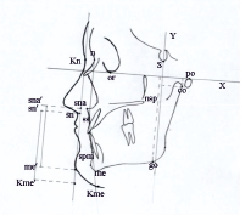
Fig. 1. Analysis of the profile telerentgenogram: X – Frankfurt plane (horizontal), held between the points po (porion) and or (orbitale); Y – the vertical, held between the points (sellion) and go (gonion); me – menton; co – condilon; n – nasion; sn' – cutaneous projection sn (subnasale); ss – subspinale; snp – spina nasalis posterior; sna' – skin projection point sna (spina nasalis anterior); Kme' – skin projection point me (menton)
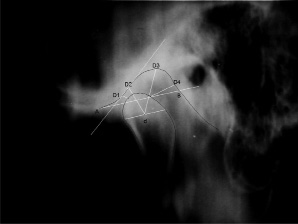
Fig. 2. Tomogram of the temporomandibular joint. A – the top of the articular tubercle; B – the lower edge of the external auditory canal; d – diameter of the head of the lower jaw; D1 – is the width of the joint space in the anterior; D2 – width of the joint space in the anterior-upper part; D3 – is the width of the joint space at the posterior e -upper part; D4 – is the width of the joint space in the posterior part
The technique allowed us to enforce valid settings in the topography of elements of the temporomandibular joint at different degrees of change of the position of the mandible in orthopedic treatment with the aim of normalizing its position. For this purpose, a computer program for determining the optimal height of gnathic part of the face in patients with various forms of increased abrasion of teeth (the Certificate on registration of software № 2015619515 Software complex to determine the optimal height of the bite in patients with increased dental abrasion (TMJ2015) [6] date of state registration in the Register of computer programs 04 September 2015 was worked out. Passport data of a patient are inserted in a computer program, followed by a tomogram of the patient’s temporomandibular joints (right and left) made before treatment. Finally, reference points are set and program after calculation determines the amount by which it is necessary to increase the height of the gnathic part of the patient’s face.
Quality of orthopedic treatment was tested by the tone of actually masticatory muscles. As the process of reduction of the gnathic part of the person’s face takes decades, the chewing muscles get used to this particular isometric height. With the normalization of the occlusion and increasing the height of the bite, the muscle tone of the rest increases, and the tone of the muscle tension decreases. With properly determined height of gnathic part of the face, the tone parameters of calm and tension come back to the original state in for about two weeks.
Myotonometry was performed using myotonometry SZIRMA (METRIMPEX, Hungary). Myotonometry scale is calibrated in grams. Myotonometry dipstick was placed to the motor points on the right and left of actually chewing muscles and the tone of the rest (TP) and the tone voltage (VT) was measured.
For accurate location of the motor points during re-examination of the masticatory muscles we used our proposed method (Patent for invention “Method of evaluating the quality of prosthetics” No. 2617229 Registered in the State register of inventions on April 24, 2017) [7].
For this primary survey on the lateral surface of the patient’s face the transparent plate (x-ray or thick plastic film) was imposed strictly to the landmarks: the middle of the tragus of the ear and the outer edge (corner) of the orbit. Motor point marked by the dye was transferred on the transparent plate (fig. 3).
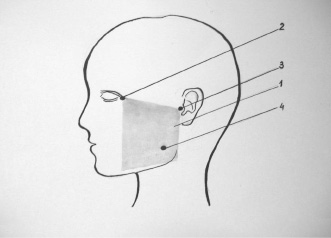
Fig. 3. Diagram of motor points of the actual chewing muscles to hold myotonometry: where, 1 is a transparent plate; 2 – the lateral edge of the orbit; 3 – the tragus of the ear; 4 – motor point of actually chewing muscles
During the second study we put the film, respectively to benchmarks and through the hole marked motor point on the skin of the patient. This method allowed to carry out identical measurements.
Results of research and their discussion
To illustrate the efficiency of complex treatment here is an extract from a case history No. 102 of patient P. 68 years with complaints of difficulty in chewing and aesthetic disadvantage (Fig. 4).
The distal position of the mandible is determined by photostations. The results showed that the height of the upper part of the face (n – sn) did not meet the lower face (sn – gn). The severity of nasolabial folds indicates a decline in the height of the gnathic part.
During the examination of the oral cavity of the patient a decrease in the height of gnathic part, the presence of defects of dentition on the upper and lower jaws, cross-bite were objectively noted. Tomography of the temporomandibular joints determined the distal position of the head of mandible, which allowed to make up a diagnosis of decompensated vertically distal form of increased abrasion of the front teeth of the upper jaw (Fig. 5).
During the examination decrease in the height of the gnathic part, moderately drooping corners of the mouth, intensive pattern of the nasolabial and chin folds was revealed. In the mouth cavity: increased abrasion of anterior and posterior teeth of the upper jaw, the 2nd degree decompensated form, the upper and lower jaws included bilateral defects of dentition in lateral parts.
The patient underwent teleroentgenographic study and imaging of the temporomandibular joints.
Measurement of parameters of the teeth and dental arches was carried out on plaster models of the jaws and directly in the mouth cavity. Occlusal relationships were evaluated, which showed non-physiological distribution of contact points, their asymmetry. In addition, the patient demonstrated the violation of the occlusal plane.
The results of the analysis of teleroentgenogram in the lateral projection showed that the position of the upper jaw corresponded to the norm, while the lower jaw was moved back, which led to an increase in ANB angle, the magnitude of which took positive values ( + 3O). Genial angle was in the range of 118 – 124 degrees, but gnathic angle (between the mandibular and spinal planes) was in the range of 20 – 22 degrees, which resulted in a decrease in the height of gnathic part (Fig. 6).
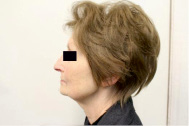
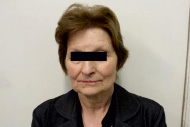
А B
Fig. 4. Face photos patient P. 68 years before treatment. A – profile, B – in front
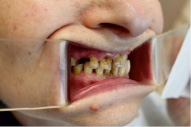
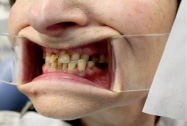
Fig. 5. The ratio of the dentition of the patient P., 68 years
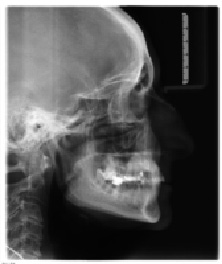
Fig. 6. Teleroentgenogram of patient P. 68 years in the lateral projection
X-ray examination of the temporomandibular joints identified the impairment of the normal topographical relations of elements of this articulation. The articular heads of the mandible on the left and on the right were shifted back, the expansion of the joint space in the anterior and narrowing in the back dpts was noted. The angle of the slope of the articular tubercle, the size of which differed from the normal values on both sides was of importance (Fig. 7).
According to the computer program “Software complex for determining the optimal height of the bite in patients with increased dental abrasion (TMJ2015)” the increase in height of gnathic part 4.6 mm was recommended.
The patient was proposed a preliminary orthopedic treatment of uncoupling the bite plate with the increase of vertical dimension 4.6 mm, to normalize position of the heads of the lower jaw shifted forward by 1.5 mm.
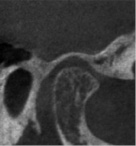
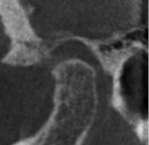
А B
Fig. 7. Tomogram of the temporomandibular joints Patient P. 68 years before treatment. A – right joint, B – joint left
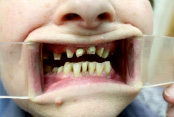
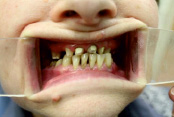
Fig. 8. Preparation of the oral cavity of the patient P. 68 years for prosthetics
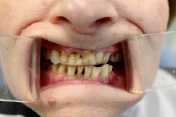
Fig. 9. Patient P. 68 years on the stage of the preliminary orthopedic treatment
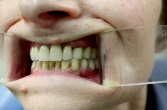
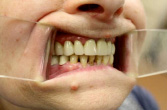
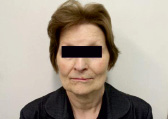
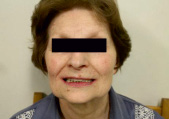
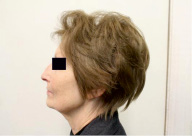
Fig. 10. Face photos of the patient P. 6 years after orthopedic treatment
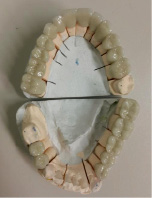
Fig. 11. Metal-keramik bridges of patient P. 68 years on plaster models
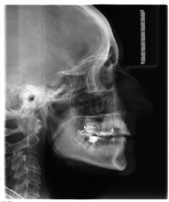
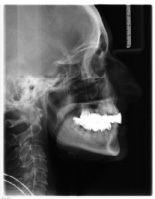
А В
Fig. 12. Side telerentgenogram of patient P. 68 years. A – pre-treatment. B – after the final orthopedic treatment


А В
Fig. 13. Tomograms of the temporomandibular joints of the patient P. 68 years after orthopedic treatment
Two weeks later, the tone of the masticatory muscles of the patient returned to normal, and after 3 months (after preparation of the abutment teeth) the final prosthetic metal-ceramic bridge prostheses with increase of the gnathic part of the person 4.6 mm was performed.
The effectiveness of the mastication increased from 20.1 + 0.7 percent (preliminary phase) to 78.2 + 1,2 % after orthopedic treatment. Time of chewing: before treatment – 52.9 + 1,4 sec. after the orthopedic treatment – 23.4 + 0.5 sec. (figure. 8, 9, 10, 11, 12, 13).
A number of diseases, including high attrition of natural teeth cause spatial variations in the chewing- vocal apparatus that affect the chewing muscles and TMJ, which are in their scope of activity and rest, and going beyond these limits leads to disorders followed by decompensation of supporting apparatus of the teeth. An aggravating factor can be parafunction of chewing muscles, diseases of the TMJ and as a consequence some structural changes. It is therefore essential to define the parameters of changes in the position of the elements of TMJ from the value of the normalization of the height of gnathic part of the person’s face.
In orthopedic treatment of such patients the primary is clinical method, based on the doctor’s experience, accompanied by laboratory methods, in particular the TWG research and imaging of the TMJ that help to clarify medical tactics, previously developed during the clinical examination of patients. Long-term results have confirmed the effectiveness of its construction in orthopedic treatment of such patients.
Imaging of the TMJ allows to obtain a correct mapping of the true state of TMJ elements and their intra relationships and to clarify the features and regularities of changes during the process of increase of the height of gnathic part of the person’s face.
Conclusions
According to the results obtained studies, you can determine the amount of dissociation of dentition in patients with increased dental abrasion, taking into account the possibility of staged or simultaneous orthopedic treatment.
The proposed computer program allows to simulate the correct position of the elements of the temporomandibular joints taking into account the normalization of the height of gnatichesky part of the person at patients with different clinical forms of increased abrasion of teeth.
The proposed method of assessing the quality of prosthetics allows to check the correctness of the chosen tactics of orthopedic treatment of patients with increased dental abrasion.
The author confirms that the submitted data does not contain conflict of interests. GRATITUDE The work was prepared with the support of the Ministry of education and science Of The Russian Federation.
Библиографическая ссылка
Balakhnichev D.N., Subbotin R.S., Fischev S.B., Lepilin A.V., Sevastyanov A.V., Orlova I.V. NORMALIZATION OF OCCLUSION IN PATIENTS WITH INCREASED DENTAL ABRASION // European Journal of Natural History. 2018. № 4. С. 37-45;URL: https://world-science.ru/ru/article/view?id=33904 (дата обращения: 08.01.2026).

